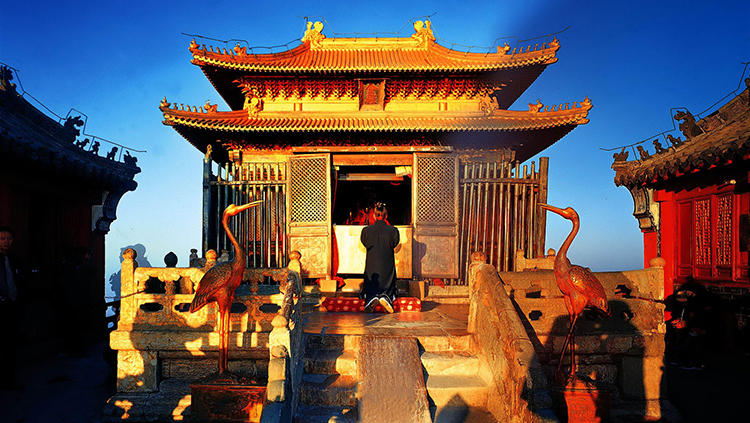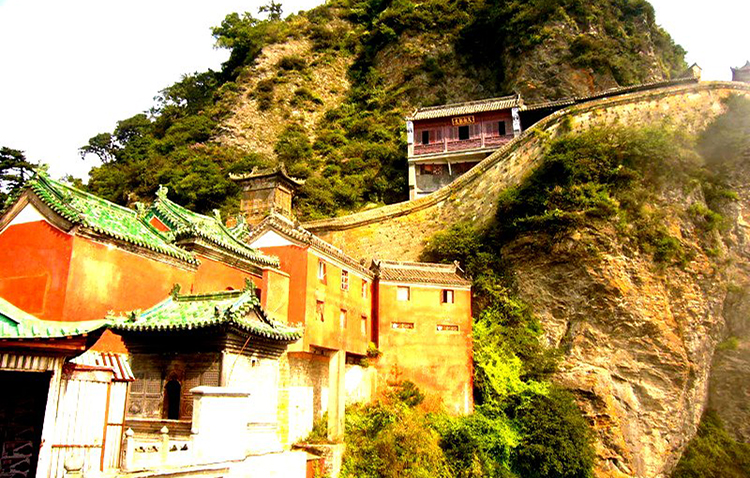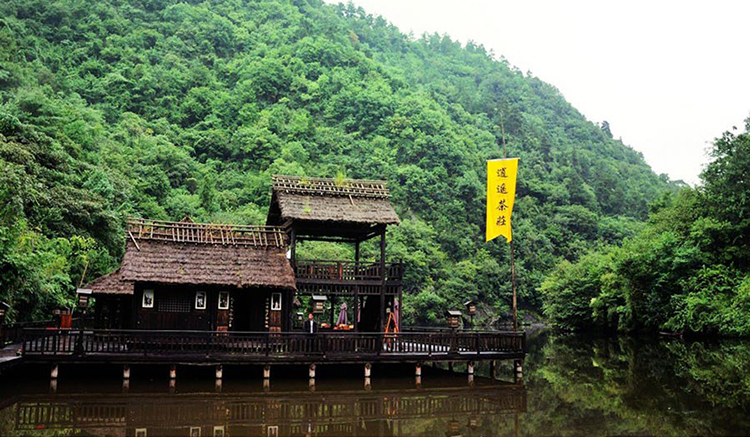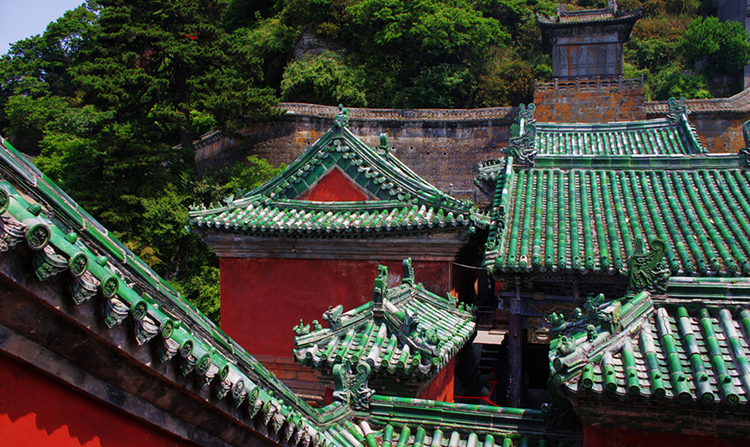Written by: Feng Yang
Posted on: May 04, 2016 | 
Ancient Building Complex in the Wudang Mountains
In 1994, 582 years later, these buildings were collectively inscribed on the UNESCO list of the World Cultural Heritages. A report by the UNESCO World Heritage Committee describes them as a “perfect combination of typical Taoist architecture with natural landscape.”
Taoism was founded 1,800 years ago in China. It is the only indigenous religion practiced in the country, relative to Buddhism, Christianity and Islam, which are alien religions. Followers of Taoism have the lifelong pursuit of becoming immortal through self-cultivation, believing that the divine world embraces not only heaven but also earth. In their minds, places with a surpassing natural beauty and unique landscape are “lands of happiness” with channels leading to paradise – or “Heaven” – as the Chinese would call it.

The Wudang Mountains, occupying an area of 312 square kilometers, are exactly a place of this kind. Far back in the 2nd century, it was already somewhat “holy”, hosting those who came to practice austerities or just to live in seclusion, free from wars and social turmoil.
Mount Wudang already had a range of Taoist palaces, temples and monasteries in the Yuan Dynasty (1279-1368). Unfortunately, most of these were reduced to ruins in wars before the dynasty collapsed. It was Zhu Di, or Emperor Yongle of the Ming Dynasty (1368-1644), who ordered the reconstruction and expansion of Taoist buildings on the mountains. During his reign, nine Taoist palaces (gong), nine large temples (guan) and 36 nunneries were built, along with 72 smaller temples and some pavilions. With the highest peak as the center, these are now found on the 72 surrounding peaks and on banks of 24 streams. Somewhere between 200,000 and 300,000 soldiers and civilians spent 12 years building these religious structures, and the project exhausted the government coffers of nine southern China provinces.
At the time, the influence of Taoism was beginning to dwindle and moreover, the Emperor of Yongle did not really believe in Taoism. Then why is it that the emperor spent so much money on Mount Wudang? The emperor’s inscriptions, carved on some stone tablets, seem to provide an answer. He did so, according to these inscriptions, to ask the gods for their help in governing the country, show filial piety to his parents and pray for the happiness of his people.

Zhu Di had been a prince before he usurped the imperial throne from Emperor Jianwen, his nephew, to become the third emperor of the Ming Dynasty. He had to justify what he had done. It so happened that his father, Zhu Yuanzhang, the first emperor of the Ming Dynasty, believed in the Taoist God of Genuine Prowess, and that Mount Wudang was said to be the holy shrine of the god. By launching this project, Zhu Di tried to tell the entire country that he had the same faith as his father and therefore was a filial son, and that he and his father both had the protection of the same God of Genuine Prowess in their fight for power. In short, he wanted to make his people believe that his throne had been passed on to him by a divine force.
Combination of the monarchical authority with the divine powers of the God of Genuine Prowess features the layout of those palaces and temples built under Emperor Yongle. These are divided into two parts: buildings on the mountains and those at its foot.
The Jingle Palace, literally the Palace of Purity and Happiness, lies at the foot of Mount Wudang. The temple, the first to be built under the reign of Emperor Yongle, is dedicated to the God of Genuine Prowess, who had been a prince of the legendary Jingle Kingdom before he became a Taoist god through 42 years’ practice of austerities. According to a travelogue of the Ming Dynasty, the temple covered half of the area occupied by the city down the mountains and resembled the imperial palace. A road paved with flagstone connects the palace with the highest mountain peak 60 kilometers away.

The Xuanyue Gate, or the Gate of Divine Mystique, is the entrance of the mountainous scenic spot, the entrance of this “divine world”, which is a land of lush green and tranquility covered with dense forests. Along the “Divine Road” up the mountain, there is a temple every 2.5 kilometers and a palace every 5 kilometers on the way up, and all have stories attributed to them. One is said to be where the God of Genuine Prowess practiced austerities and became immortal.
Divine power, no matter how great, must be submitted to monarchical authority. This unshakable principle of feudalism was strictly followed in construction of the Taoist buildings on Mount Wudang.
The Zixiao or Purple Skies Palace had been the center of the Taoist structures on Mount Wudang before the Ming Dynasty, people of the previous dynasty, the Yuan, believing that the neighboring Nanyan or South Rock Palace was where the God of Genuine Prowess lived. Emperor of Yongle, however, designated Tianzhu or Heavenly Pillar Peak, the highest peak, as the center of this Taoist shrine. The peak overlooks all other peaks, and Emperor Yongle likened the peak to himself, with his court ministers paying tribute to him. On the orders of the emperor, a copper palace was built on the very top of the peak, which is 160 square meters in area. The structure is called the “Golden Palace” because it is a gold-plated structure and is modeled on an imperial building. A statute of the God of Genuine Prowess is worshipped in the Golden Palace. It is said that the statue, 1.86 meters high, was modeled on Emperor Yongle.

Three years after the Golden Palace was built, also on imperial order, a wall of rectangular stone slabs was constructed round it, and the palace was renamed “Purple Golden City”. One has to remember that Emperor Yongle lived in the Forbidden City in Beijing, which is also known as the “Purple Forbidden City”.
Down the mountain from this “Purple Golden City” is the Taihe Palace, alias Temple of Tao. In the Ming Dynasty, the Purple Golden City was forbidden, and the Temple of Tao was the last Taoist shrine they were allowed to enter.
The God of Genuine Prowess is not the highest Taoist god. Despite that, Emperor Yongle made his shrine the most imposing and magnificent of all Taoist shrines in the country. He personally took charge of the project, on which he issued more than 60 orders, and saw to it that everything was done to his satisfaction. For a time, there were 4,000 Taoist monks and nuns on the mountain, who were chosen among Taoists from all over the country. In 1416, 3,100 people in 500 families elsewhere in China were moved to Mount Wudang, and were charged with producing food for those Taoist monks and nuns. Not long afterwards, 500 troops were dispatched to this imperial holy site. Ironically, Emperor Yongle had never been to the mountain before he died, and neither had any of the 15 Ming emperors after him.
Taoism stands for harmony between Man and nature, believing that Man is an integral part of nature. This principle was strictly observed in the construction of this Taoist shrine. Based on an order of Emperor Yongle, the felling of trees on the mountain was forbidden, and so was anything that may adversely affect the original landscape of the mountains.
The basic layout of the Taoist shrine has never changed, although some more temples were constructed and some renovations were done after Emperor Yongle died. In 1552, Emperor Jiajing ordered the renovation of 955 rooms and chambers in temples and palaces on the mountain. In 1642, peasant rebel troops under Li Zicheng burned down the local government office charged with administering religious affairs. With the collapse of the Ming Dynasty two years later, the imperial Taoist shrine became open to the general public. No new buildings have been constructed ever since. Many temples and palaces have been deserted, despite repeated renovations. More than 200 buildings have been preserved to this day, which together have a construction space of 50,000 square meters. As always, these are home to Taoist monks and nuns. Visiting all these buildings takes at least five days.
You may also like: